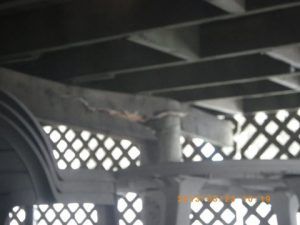Summer! Time to Get Your Deck in Ship Shape
While a ship’s captain may have a little time to batten down the hatch and get all hands on deck when he smells a storm, your deck may not give you the chance before it collapses.
Your deck is where you relax, toast your daughter’s graduation, and celebrate summer. But a deck can also be one of the most dangerous areas of your home. According to the North American Deck and Railing Association, at least 30 deaths were reported between 2000 and 2008 as a direct result of deck collapses, and more than 75 percent of people get injured or killed when a deck collapses. Decks collapse without warning: it is extremely important for homeowners to check their deck, or have it checked by a professional.
DO NOT HOST A HOUSEWARMING PARTY ON THE DECK SHOWN BELOW!

Shiver me timbers
Just like your roof, decks are subject to environmental conditions such as rain and snow. They take a beating every winter. The best time to check vital signs is in the spring.
Some of the key items that need to be looked at are:
Movement
Loose or damaged support beams and planking, wobbly handrails or guardrails or other –even slight- movement could be signs that your deck needs some reinforcement.
Quality of lumber grade
Usually determined through the stamp on the lumber, preservative pressure treated lumber should adhere to American Softwood Lumber Standard requirements.
Connections
The type, locations and edge distances of all connections need to be checked to ensure they comply with industry standards. If the gap between your deck and your home is widening, if you see splits or cracks in the wood, or nail pullout (popping), your deck needs some attention. Often, deck constructions done with nails are more privy to environmental damage, and can compromise the safety of your deck.
Decay
Rotting wood, warped or cracked wood, rust, iron stains or other signs of corrosion are all early warning signs that your deck needs some attention. All materials used to build the deck should be in good condition including metal fasteners, wood, and posts. Specifically, the posts should not be exposed to weather at all. Structural elements need protection when they are in contact with the ground or masonry. Exposure to sprinklers, pools, improperly maintained gutters or other water exposure can speed decay.
Insects
The most common culprits are termites, ants, beetles and bees. Beetles lay eggs in tunnels in wood. Carpenter ants like to make nests in wood that is already somewhat decayed. Termites are more likely to build tunnels right below the surface of the wood. All of these insects can destroy lumber at an alarming rate, especially around fasteners and connections that your deck needs to remain structurally sound.
Get your deck in ship shape
Spring is in full swing. You just changed your propane tank, you’ve called your friends and you’re ready to grill. -But you just have to make sure your deck can take the heat. If you’ve ever second-guessed the safety of your deck, put down that hammer and think twice – do you really think a couple of reinforcing nails are going to do the trick?
If you’re not sure, we can help. Make sure you don’t end up walking the plank!
After two men died when a balcony collapsed last December 2015, with a third seriously injured after a railing gave out on third-floor balcony in Lachine, Ivan Mose was asked to better explain how to spot deck problems for the Gazette in this video. It wasn’t the first incident. A few years before, a woman fell to her death from a balcony in N.D.G. and five were injured in N.D.G. when another apartment balcony collapsed in 2011. -And in 2010, a fourth-floor balcony gave out in a building in St. Laurent.

